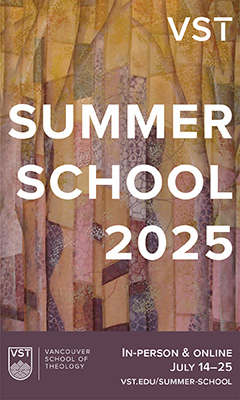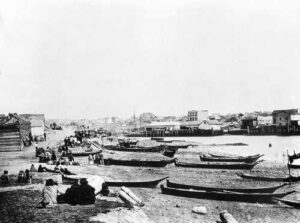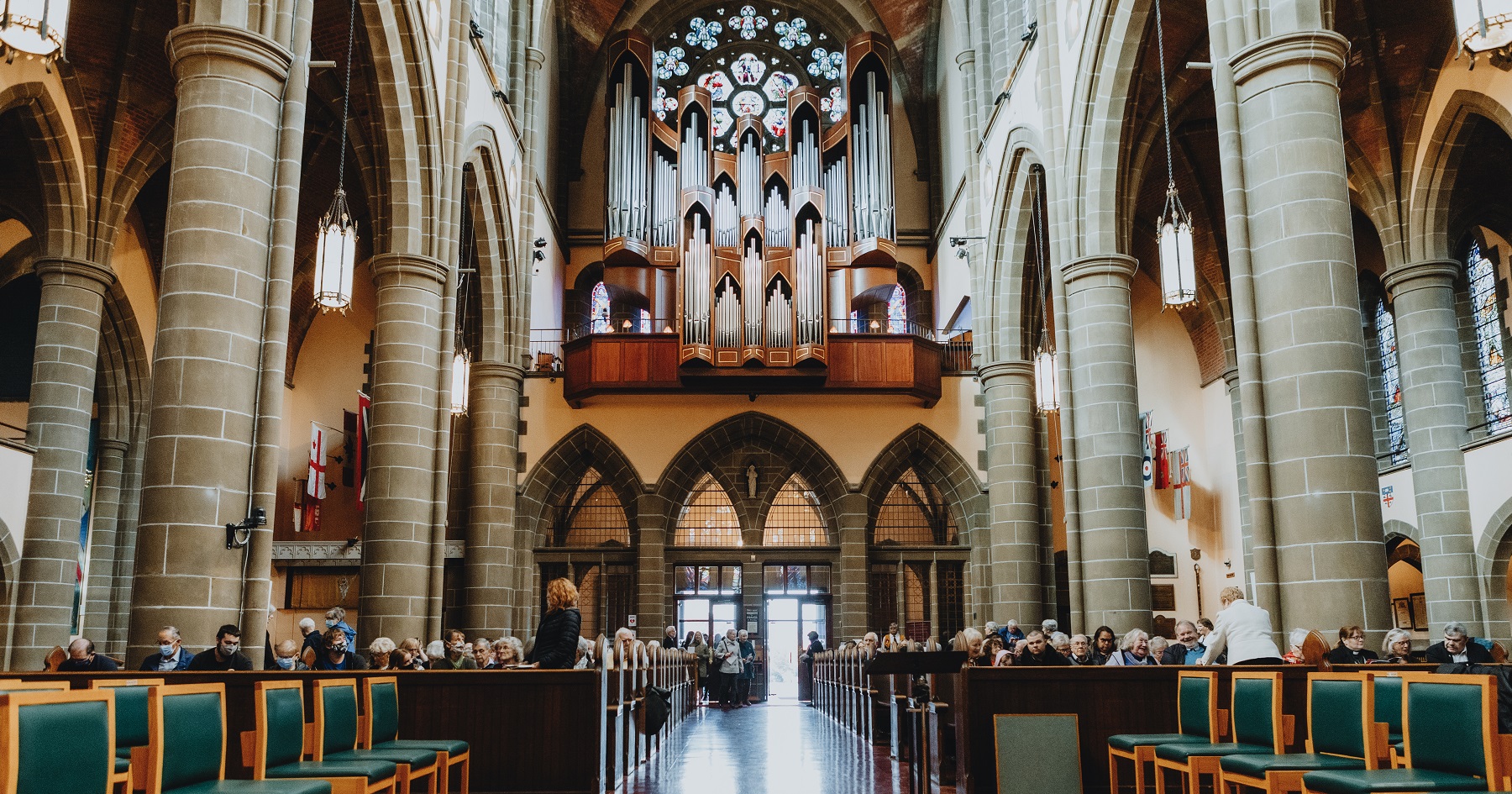The following is a sermon delivered by Jesse Robertson at Christ Church Cathedral, Victoria on June 23, 2024.
For those of you who don’t know me, my name is Jesse. I am a parishioner of this cathedral, and a PhD candidate in history at the University of Victoria. I’m also a historical consultant. For the past year and a half, I’ve been working with the diocese to better understand how we came to acquire various church lands across Vancouver Island, and to place those properties within the broader history of colonization that many of us are becoming more aware of. It’s an honour to have been asked to share a part of that history with you today.
If you look to my right, some of you will be able to see the image of Saint Matthias in a stained glass window. In his hands he carries the original Christ Church — a wooden structure that stood about a block west of us, on the land now occupied by the provincial courthouse. It was built in 1856 in what remained an inconsequential settlement at the edge of an empire — before the gold rush, before the founding of this diocese — by a priest whose predecessor had died in a shipwreck while trying to leave the island just two years earlier. It was an act of profound trust that this place would be one where Christians might gather in prayer for generations to come. We owe a real debt to these forerunners in faith, for having a vision of the future that, in tangible ways, included each of us.

But a church is not made by faith alone. Look again towards Matthias. Hovering above the saint and the church he carries, you will see, strange as it may seem, a corporate logo in the hands of an angel — the coat of arms of the Hudson’s Bay Company, the powerful fur trading operation that, at one point or another, exerted a commercial monopoly over most of what is now Canada. This church, we shall see, is their legacy, too.
In 1849, the British Crown gave the Hudson’s Bay Company a ten-year lease to the entirety of Vancouver Island, its land and minerals, for a paltry seven shillings a year — about $65 today. Eight million acres for less than my weekly grocery bill. In return, the company was expected to establish and administer the new Colony of Vancouver Island, and was empowered to sell and reserve land to attract loyal British subjects to settle here.
This grant relied on the convenient fiction that this land was free for the taking. But if you were to stand on this hill in 1849, the landscape around you would have been more lək̓ʷəŋən than British. A row of longhouses stood on one side of the harbour where the Delta Hotel stands today, the site of the Songhees Reserve until it was moved to Esquimalt in 1911. The area below us, where the Empress Hotel stands, was known as xwsәyq’әm, a tidal flat where people harvested clams and passed their canoes along the creek that still runs below Humbolt Street. To the south were great beds of flowering kwetlal, or camas, owned and tended by particular families who harvested its starchy, edible roots across míqən, the area we know as Beacon Hill Park. The hill where we are currently gathered was covered in ancient oak trees, where people could access hunting grounds and medicines. Every part of this land was named, known, owned and loved by the lək̓ʷəŋən from time immemorial.

The Hudson’s Bay Company at least went through the formality of signing treaties or land purchases with local lək̓ʷəŋən families in the spring of 1850. Chief Factor James Douglas signed a treaty with the family of Swenghung that covered most of the present-day City of Victoria, including the ground beneath this church, for £75 in blankets — around $15,000 today. The company considered this sufficient to proceed with land sales. lək̓ʷəŋən accounts insist it was, at best, a land sharing agreement.
It didn’t take long before the few independent settlers began criticizing company officials for inadequately supporting the young colony. The company was pressured to prove to London that it was, in fact, meeting its contractual commitment to establish a settler colony. It was in this context that it produced a map of proposed improvements for Victoria — a reservoir, gardens, a wharf, and, at the top of this hill, a proposed church. By establishing a church — an Anglican church — the Hudson’s Bay Company sought to demonstrate its commitment to settling this island and encouraging a culture of loyalty to the British Crown. The church was a small, but important piece, of corporate efforts to defend their presumed title to this island.
But the company, intent on maximizing return for its shareholders, was understandably reluctant to bankroll a church whose priests would not contribute directly to profits. And so what do they offer instead? Remember, they have a piece of paper signed in London saying this island belongs to them, and that they may sell and reserve land as they wish. And so they do, reserving substantial lands for the Anglican Church to farm or rent for its own profit. Now, for context, the current cathedral precinct, this one city block, is about three acres. In 1858, the Hudson’s Bay Company surveyed a church reserve encompassing 23 acres. We are currently gathered on the final remnant of that reserve, which once stretched from the back of this church almost to Douglas Street, south to xwsәyq’әm — the tidal flat buried under the Empress — and back east along McClure Street. Seven blocks of prime real estate in what has become one of the most expensive real estate markets in the country.
The reserve was formally deeded to our diocese in 1864, making it possible not only to farm and lease land, but also to subdivide, sell and mortgage it to turn a profit. At the time, the land was valued at $60,000 — around $3,000,000 today, according to my napkin math. Consider how fortunate you would be to invest that kind of money in the housing market just 15 years ago. Now consider what it would mean to invest that money over 150 years ago. Stripped of every building upon it, the land we were given alone is worth something like $240,000,000 today — a quarter of a billion dollars. All the more shocking, when we recall what the lək̓ʷəŋən received for a much larger piece of land the previous decade: just $15,000 — less than one percent of what the church reserve was worth in 1864. This is one of those moments where we can see the fortunes of settlers and Indigenous people fundamentally diverge; a moment that would be repeated every time a stretch of Indigenous territory was surveyed, fenced and sold to the highest bidder.
It would, perhaps, be unfair to fault our forebearers in accepting such gifts. But gifts often come with unstated obligations to the giver. In accepting this land from the Hudson’s Bay Company, as if it were theirs to give, our church benefited materially from the dispossession of an oppressed people and accepted an equivalency of Christianity and civilization which, at its worst, has provided the justifying ideology for residential schools that sought to strip Indigenous children from their culture.
The last piece of the church reserve, where the Court House sits today, was sold to the province in 1937. And now we are left to grapple with this dual inheritance: a gift that is not only a gift, but a responsibility. These are not entirely new concerns. They appear throughout scripture, which, comfortable Christians sometimes forget, is fundamentally a story of God’s faithfulness to a people oppressed, and often corrupted, by empire.
Today we heard the famous story of David and Goliath (1 Samuel 17), which we fairly read as a story about trust. David removes his sword and armour, trusting in the common sling of a shepherd, in his confrontation with the giant Goliath, who approaches with a bronze helmet, coat of mail and massive spear. The battle comes at a crucial moment for the people of Israel, who, a few chapters earlier, rejected their God by demanding a king to rule over them instead, ignoring the prophet Samuel’s warning that the king would seize the best of their fields and vineyards (1 Samuel 8). That prophecy was later fulfilled in the story of King Ahab, who executes one of his subjects, Naboth, for refusing to sell his vineyard (1 Kings 21). Naboth’s last recorded words, “The Lord forbid that I should give you my ancestral inheritance,” have been echoed by people confronting colonization on this coast for over 150 years. Steps away, in our archives, is a hundred-year old letter from Kwakwaka’wakw leaders, summoning the Anglican bishop to help them protect their ancestral inheritance: “We want our rights, as the proper owners of this Country that God gave to us and our forebears.”
The story of David and Goliath is one of trust in God, but it is equally a parable of caution against the powers and principalities of this world. The passage is careful to note that the sword and armour David abandons were given to him by none other than Saul, the king against whom Samuel warned the Israelites. The king’s gifts are so heavy that David is literally immobilized, unable to walk, let alone face his adversary. It is in shedding them, and accepting his reliance on God alone, that David overcomes Goliath and gives glory to his creator.
We, too, are the recipients of a loaded gift, a past that has, and will, continue to define us. But we are not the first community to confront such legacies. Churches have been active in the land justice movement, finding creative ways to recognize our role in the theft of this continent. The Shalom Mennonite Fellowship in Tucson, Arizona has an annual budget item allocating to Indigenous organizations part of their property tax exemption. In 2019, the Anglican Diocese of New Westminster instituted a tithe, offering 10% of future property sales to Indigenous communities. In the 1990s, our own diocese restored almost 140 acres of Cormorant Island to ‘Namgis First Nation, in the very place where we once ran a residential school.
There are many dimensions to this history. The story of our church in this land is a story of a people that would travel to Indigenous villages to learn their names and languages, while campaigning against their sacred ceremonies; who vaccinated Indigenous children against smallpox when few others were willing, and later crowded them into horrific schools; who fought for integrated churches where all races could worship together, while actively benefiting from the theft of Indigenous land. It’s the story of Indigenous people who embraced Christ and call the rest of us to follow his teachings more faithfully.
How will we, as individuals and community, steward the histories we have inherited? There is no simple answer, alas, but the question is essential. May we ask it then, confident that God is here with us, calling us to a love that has no limits. David sheds his armour, he says, “so that all the earth may know there is God in Israel.” May we, too, cast down our armour, and every encumbrance that prevents us from receiving and proclaiming a God whose love is beyond the kingdoms of this world.



